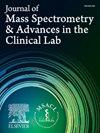液相色谱-高分辨率质谱法分离鉴定质量位移小于1da的血红蛋白变异亚基
IF 3.4
4区 医学
Q2 MEDICAL LABORATORY TECHNOLOGY
Journal of Mass Spectrometry and Advances in the Clinical Lab
Pub Date : 2025-01-01
DOI:10.1016/j.jmsacl.2025.01.002
引用次数: 0
摘要
背景血红蛋白(Hb)变异的鉴别在临床检测中是有价值的。识别Hb变异的常规方法的一个共同问题是它们提供变异结构分解的能力欠佳。高分辨率质谱(HR-MS)方法的报道已经浮出水面,这些方法改进了传统方法;然而,在HR-MS分析之前,如果没有分离Hb亚基,可能会产生歧义。方法采用液相色谱-高分辨率质谱(LC-HR-MS)方法分离出质量位移小于1 Da的正常和变异Hb亚基,并在完整蛋白和自上而下分析中成功鉴定出它们。C4反相柱有利于LC分离。结果选择α-地中海贫血特征的Hb C、Hb E、Hb D-Punjab、Hb G-Accra、Hb G-Siriraj、Hb Tarrant和Hb G-Waimanalo 7个Hb杂合变异体样本,证实了Hb变异体与正常亚基的LC分离,质量位移小于1da。分析物可以在反卷积的MS1质谱中清晰地观察到。自上而下的分析与正确的Hb变体亚基的氨基酸序列相匹配。结论所描述的LC-HR-MS方法可以有效地分离和鉴定Hb亚基,特别是当变异亚基与相应的正常亚基的质量偏差小于1 Da时。随着对其临床实用性的进一步评估,包括CE-HR-MS在内的HR-MS方法有可能在临床实验室补充或部分取代传统的Hb变异鉴定方法。本文章由计算机程序翻译,如有差异,请以英文原文为准。
A liquid chromatography-high-resolution mass spectrometry method for separation and identification of hemoglobin variant subunits with mass shifts less than 1 Da
Background
Identification of hemoglobin (Hb) variants is valuable in clinical testing. A common issue with conventional methods for identifying Hb variants is their subpar ability to provide structural breakdowns of the variants. Reports have surfaced of high-resolution mass spectrometry (HR-MS) methods that improve on traditional methods; however, ambiguities may arise without separation of Hb subunits prior to HR-MS analysis.
Methods
We report a liquid chromatography-high-resolution mass spectrometry (LC-HR-MS) method to separate several pairs of normal and variant Hb subunits with mass shifts of less than 1 Da and successfully identify them in intact-protein and top-down analyses. LC separation was facilitated by a C4 reversed-phase column.
Results
Seven heterozygous Hb variant samples (Hb C with α-thalassemia trait, Hb E, Hb D-Punjab, Hb G-Accra, Hb G-Siriraj, Hb Tarrant, and Hb G-Waimanalo) were selected to demonstrate the LC separation of Hb variant and normal subunits with mass shifts of less than 1 Da. The analytes could be explicitly observed in the deconvoluted MS1 mass spectra. The top-down analysis matched the amino acid sequences of the correct Hb variant subunits.
Conclusions
The LC-HR-MS method described can effectively separate and identify Hb subunits, especially when the variant subunits have mass deviations of less than 1 Da from their corresponding normal subunits. With further evaluation to prove the clinical utility, the HR-MS methods including CE-HR-MS have the potential to complement or partially replace conventional methods of Hb variant identification in clinical laboratories.
求助全文
通过发布文献求助,成功后即可免费获取论文全文。
去求助
来源期刊

Journal of Mass Spectrometry and Advances in the Clinical Lab
Health Professions-Medical Laboratory Technology
CiteScore
4.30
自引率
18.20%
发文量
41
审稿时长
81 days
 求助内容:
求助内容: 应助结果提醒方式:
应助结果提醒方式:


